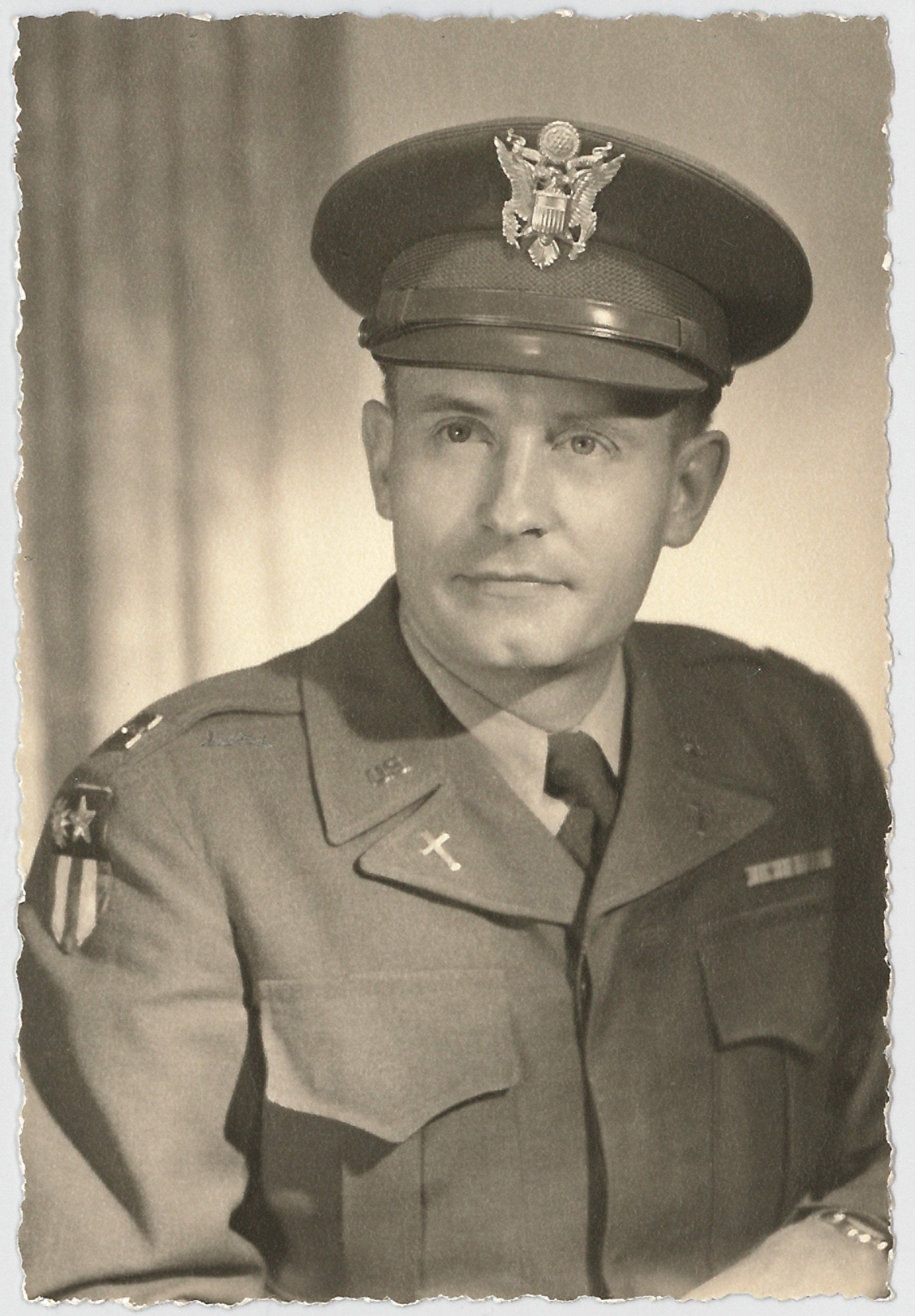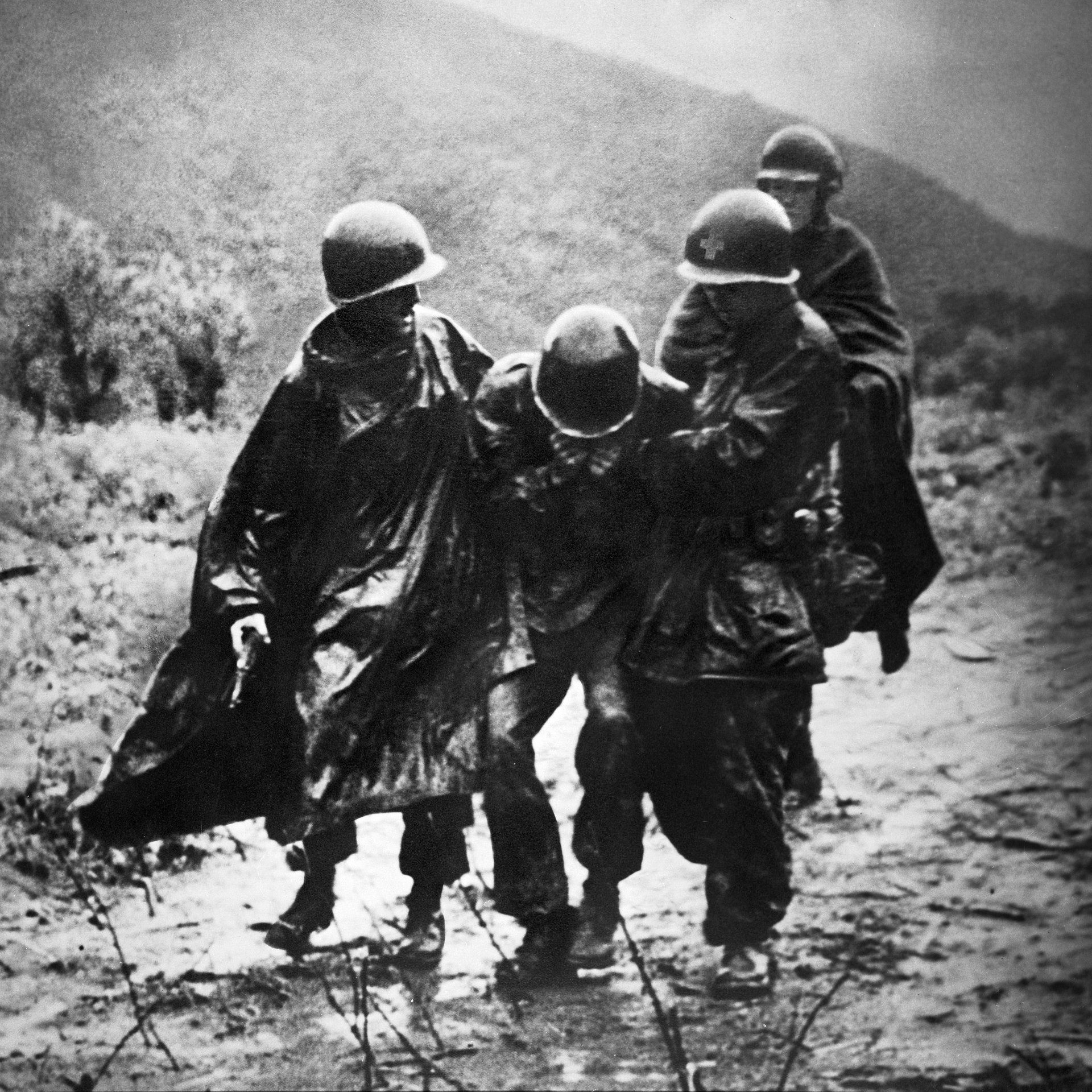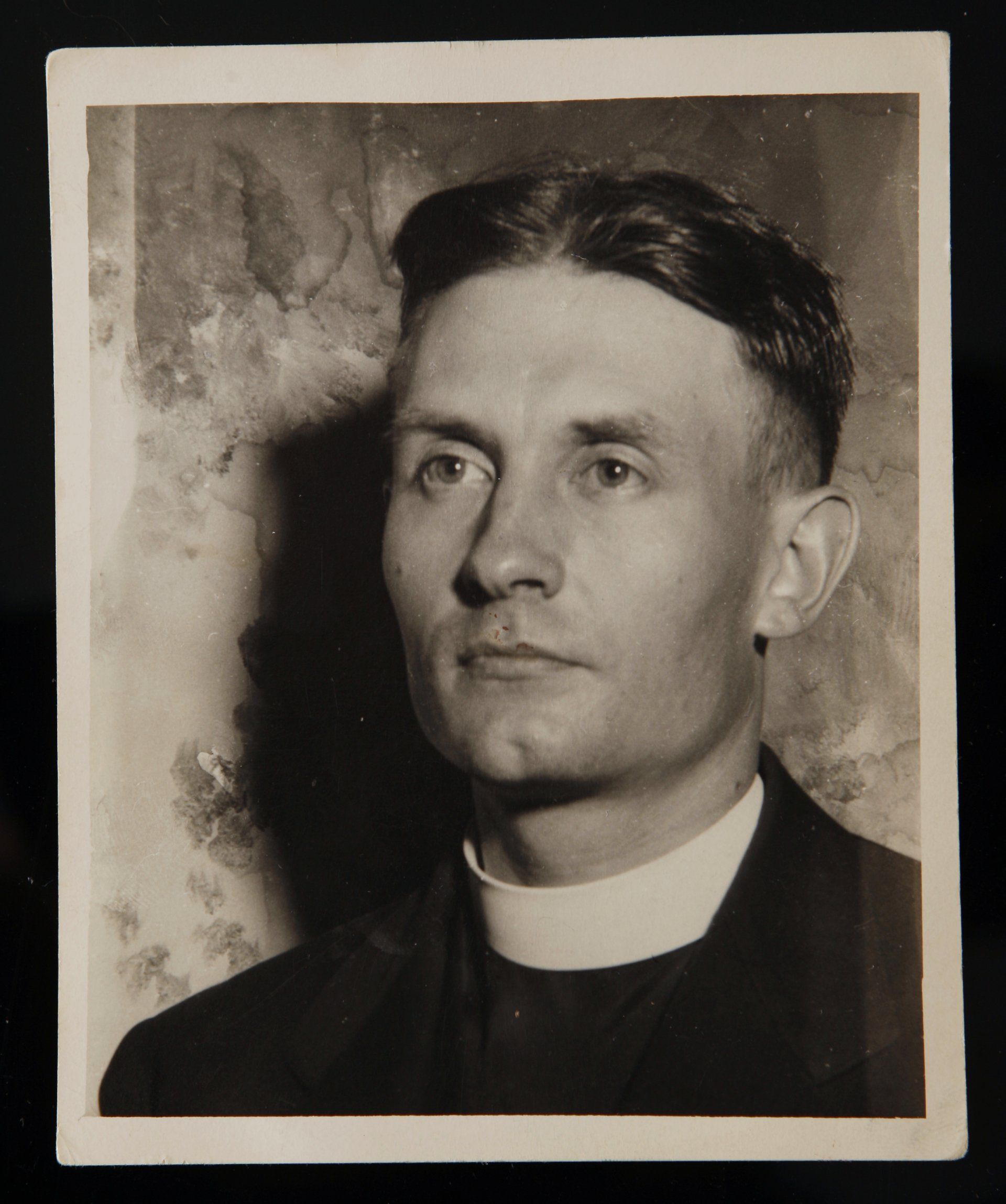a father for all seasons
Recipe for Success From a Mompreneur
Written by Amy Palser
On Path to Sainthood, the Late Fr. Kapaun Touches Lives Along the Way
WRITTEN BY John Huthmacher

Taken either in 1946 or 1949 with the rank of Captain. Courtesy of Les Broadstreet

Battalion Surgeon Capt. Jerome Dolan (left) and Chaplain Kapaun (right) assist a weary soldier off the frontlines during the Battle of the Pusan Perimeter in late summer 1950 after nine days and nights of fighting, outnumbered at least 10 to 1. Courtesy of Col. Raymond Skeehan

Father Kapaun on July 2, 1944

Father Kapaun enjoyed playing sports with the kids at recess, even buying them baseball and soccer equipment. This photo was taken in Pilsen between 1940-1943.
The same spirit that compelled Father Emil Kapaun to become a priest ultimately drove him to battlefieldsand prison camps as a U.S. chaplain during World War II and the Korean War, to rescue U.S. soldiers through countless acts of heroic bravery. His innate ability to lead by example, oftentimes risking his own life in the process, continues to drive his cause for sainthood today, capturing both headlines in the media and the hearts of those whose lives have been impacted by his life-saving interventions.
A posthumous Medal of Honor recipient, he is credited with saving the lives of countless prisoners held captive during the Korean War. Recognized by the Roman Catholic Church as a Servant of God in 1993, his cause for sainthood continues to gain momentum as he approaches step two, Venerable, in the four-step declaration process.
Seventy years after his death in a prison camp, it was announced in March 2021 that Kapaun’s remains were identified, and on Sept. 29, 2021, were entombed inside the Cathedral of the Immaculate Conception in Wichita within the Diocese where he was ordained. On campus at Kapaun Mt. Carmel High School in
Wichita, Kapaun is celebrated year-round by faculty and students through such activities as homecoming, parades, Masses and school essay assignments.
Rob Knapp, president of Kapaun Mt. Carmel, said he believes the revered priest's life story exemplifies what a Christian lifestyle should look like. Accounts of Kapaun's daily walk have inspired many who desire a closer relationship to Christ. That his journey to sainthood keeps his name and example in the limelight is perhaps its greatest blessing to believers everywhere.
“Father Kapaun's life, particularly at the end when he was dealing with being captured and in captivity with the other American soldiers in the Chinese prison camp, really exemplifies the virtues that we are called to live out on a daily basis,” Knapp said. “The reason I believe Father Kapaun is where he is, is because he is a
man of heroic virtue. When we look at the cause for canonization, we're looking at those people we believe to be in heaven and looking at their lives as being the type of lives that we as fully alive humans on this earth need to exemplify, follow and imitate.
“What we're trying to do with this cause for canonization is look at those virtues he lived out on a daily basis, virtues we want to follow and imitate. His cause is not necessarily a linchpin that propels our school into some new area or something that makes us any greater. It helps us spread the story across the world of this man, who we certainly celebrate in a spirit that allows us to share his virtue with the rest of the world.”
An Ordinary Boy
The eldest of two sons, Kapaun lived a rather ordinary childhood growing up in Pilsen, Kansas, about 60 miles north of Wichita. The son of Enos and Elizabeth Kapaun divided his daily routine between playing baseball, riding his bike, and doing chores on the family farm. Yet it was during these formative years that he found himself drawn to a saintly life of service to others. And that is perhaps what has made him such an inspirational figure to everyday people also striving to lead exemplary lives.
Scott Carter, coordinator for Kapaun's cause for sainthood at the Catholic Diocese of Wichita for the past seven years, said he thinks it is the simplicity of Kapaun's humble beginnings that have made him seem particularly accessible to believers with seemingly less than exemplary spiritual resumes.
“He was just an ordinary boy,” Carter said. “In most ways, he wasn't that spectacular. His ordinariness is inspirational: If God’s grace can use him, it can use us too. He lived his faith and was always looking to help other people. He wanted to bring others to God.”
‘Father Kapaun's life, particularly at the end when he was dealing with being captured and in captivity with the other American soldiers in the Chinese prison camp, really exemplifies the virtues that we are called to live out on a daily basis.’ - Rob Knapp
Upon completing seminary, Kapaun was ordained on June 9, 1940, and returned to his home parish of St. John Nepomucene to begin his priesthood. His desire to help restore hope to those struggling through difficult times led him to enter the U.S. Army Chaplain Corps in 1944. Offering Masses on the hood of his
Army jeep as circumstances dictated, his ability to connect with the downtrodden made him hugely popular among the troops, whether Catholic or not.
“Even though the communists didn’t allow them to have prayer services, he would sneak around and pray with the men,” Carter said. “He would do whatever he could to keep them going.”
His fearless actions under fire endeared him to those who needed his intervention to brave the less-than humane conditions facing them daily on the battlefield or prison camp. “Father Kapaun's self-sacrifice for his brothers, going from foxhole to foxhole and running towards bullets to take care of them, is
something that really resonates with people who hear his story,” Carter said. “I can't help but think this man is in heaven, and it will be a joy in seeing that declared. From the beginning of the fighting, he earned the reputation for sticking his neck out to visit the men on the front lines, oftentimes barely escaping by the skin of his teeth.
“He had a pipe shot out of his mouth, the bullet missed him by inches — but that didn’t deter him from being where the men were. He knew he needed to be there to administer the sacraments.”
A Beacon of Hope
It was during the Korean War battle of Unsan on Nov. 1–2, 1950, that Kapaun's role in the war effort escalated to new heights. Told to flee to safety by his allies, he chose instead to stay the course, rescuing as many as 40 wounded men from the battlefield.
Captured in the effort, he would spend the next seven months as a prisoner of war, eventually succumbing to illness on May 23, 1951, in a communist POW camp. He was 35.
His ongoing efforts on behalf of U.S. troops lifted spirits and saved lives. In an atmosphere wrought with hopelessness, his human touch sustained many who likely would have perished otherwise.
‘One of my favorite parts of the job is to hear and see how the Holy Spirit has used (Father Kapaun’s) life to inspire others to make their lives better. I am constantly surprised at the amount of good he has brought about.’ — Scott Carter
“Conditions were pretty bleak,” Carter said. “A lot of men died that first winter. He (Kapaun) would steal food for them, share his own food, and wash their clothing when they had dysentery and couldn't control their bowels. He would pick lice off them.
“When the communists held indoctrination sessions, they told the prisoners their God and country had forgotten them. He reminded them in his teachings and actions that God was right there with them.”
Though his cause continues to march forward, Kapaun’s road to sainthood is hardly secured. The process often requires years of investigation by committees to ensure each candidate’s reputation remains untarnished under scrutiny. Additionally, at least two miracles attributed to the candidate’s intercession must be verified and approved before the canonization can be finalized. And while Carter is hopeful Kapaun’s recognition comes sooner than later, he draws inspiration from the good that continues to emerge from the process itself.
“Our primary goal in a lot of ways right now is to continue to share his story and encourage prayer that continues to bear fruit, even outside the ultimate declaration by the church,” Carter said. “I take a lot of consolation in the fact that everybody I talk to and share his story with says he's a saint already. The good he has brought about is immense.
“One of my favorite parts of the job is to hear and see how the Holy Spirit has used his life to inspire others to make their lives better. I am constantly surprised at the amount of good he has brought about.
That doesn’t stop us from being impatient for it (canonization) at times, but we’re not stopping or giving up by any means.”
Father Kapaun Pilgrimage
Written by SPLURGE! staff
This month, 375 modern-day pilgrims will walk some or part of the 60-mile gravel-road journey known as “The Path to Heaven” in honor of Father Emil Kapaun. The pilgrimage, which runs June 2–5, starts in Bel Aire and ends in Kapaun’s hometown of Pilsen, Kansas.
The pilgrimage starts with 6 a.m. Mass at Church of the Resurrection in Bel Aire and ends on the fourth day with the Father Kapaun Day Mass, 11 a.m. at St. John Nepomucene, Kapaun's home parish. Participants cover 22 miles the first day, 14 miles the second, 16 miles the third day and eight miles the
final day.
Every two to three miles, the group pauses for Father Kapaun Stations, reflecting on different aspects of Kapaun’s life. Some portions of the walk are dedicated to group rosaries while others are silent times — and there is lots of time to walk and talk and meet new people. Camping in tents at night, the group has more time to fellowship and learn about Father Kapaun.
Support vehicles at the front and the back of the group carry participants’ tents, sleeping bags and belongings, and provide meals for them along the way. The walk is organized by Father Eric Weldon, the Brunke family and several volunteers.
Wanting to raise awareness of Kapaun’s beatification, Weldon set off in 2009 on foot from Wichita to Pilsen with three others. By the time he arrived in Pilsen he had picked up 10 more pilgrims.
When he did it again in 2010, he started with 37 participants and ended in Pilsen with 74. Today registration opens three months before the departure date and the 375 open spots are quickly filled.
“Pilgrimage is an ancient tradition in the church, and it’s great that it’s alive in Kansas today,” said Scott Carter, coordinator for Kapaun's cause for sainthood at the Catholic Diocese of Wichita. “The journey is a challenging but also joyful way to get to know Father Kapaun better. It’s also a great opportunity to slow down and get to know the people around you, something that I think Father Kapaun would encourage us to do more of.”
SUBSCRIBE TO SPLURGE!
Thank you forsubscribing to Splurge! Magazine
Please try again later.
ADVERTISE WITH SPLURGE!
Send us your contact information & we’ll schedule an appointment with you as soon as possible!
